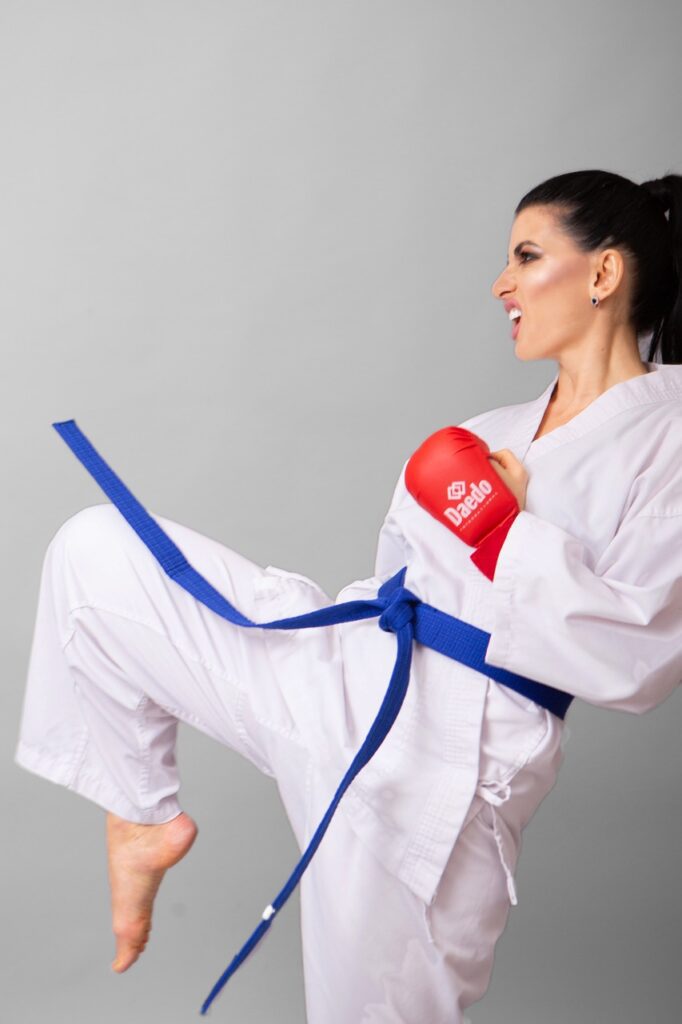In “Developing Killer Instinct: Advanced Offensive Mindset For MMA,” you’ll dive into the mental and physical strategies crucial for mastering Mixed Martial Arts at a high level. This article guides you through harnessing your inner drive, enhancing your tactical approach, and pushing past your limits. You’ll learn practical techniques to cultivate an unrelenting offensive mindset, empowering you to dominate in the cage. With these insights, you’ll be well-equipped to elevate your game and embody the true spirit of a fighter. Have you ever wondered what sets a good MMA fighter apart from a great one? It’s not just about physical prowess or technical skills; it’s also about having that “killer instinct.” Understanding and developing an advanced offensive mindset is crucial if you want to elevate your game in mixed martial arts.
Understanding the Killer Instinct
“Killer instinct” can sound a bit intimidating, but it’s not about being brutal. In the context of mixed martial arts (MMA), it’s more about possessing the mental tenacity and tactics to seize opportunities and dominate your opponent when it counts the most. Cultivating this mindset involves strategic aggression, heightened awareness, and impeccable timing.
What Is Killer Instinct in MMA?
In MMA, killer instinct is the ability to recognize and capitalize on your opponent’s weaknesses immediately. It’s about knowing when to press the attack, how to assert control, and when to go for the finish. This trait is crucial in turning a good performance into a potential knockout or submission victory.
Why Is It Important?
Developing a killer instinct can be the difference between a victory and a loss. It allows you to maximize your opportunities, take control of the fight, and ultimately finish your opponent when you have an advantage. This advanced offensive mindset enables you to channel aggression in a controlled manner, making you more efficient and effective in the cage.
Building the Foundation: Mental Toughness
Before diving into advanced offensive strategies, it’s important to build a strong foundation of mental toughness. Your mindset is your most potent weapon in the cage.
Visualization Techniques
Visualization is a powerful tool used by high-level athletes across all sports. Spend time visualizing different fight scenarios: picture yourself dominating from start to finish, landing perfect combinations, and securing submissions.
Positive Self-Talk
Replace negative thoughts with positive affirmations. Instead of thinking, “I can’t do this,” tell yourself, “I’m capable and ready.” This shift in mindset can significantly boost your confidence and performance.
Handling Pressure
MMA fighters need to stay calm under pressure. Practices such as meditation, deep-breathing exercises, and situational sparring can help you manage stress and keep a clear head during fights.
Example Table: Daily Mental Toughness Routine
| Activity | Description | Time |
|---|---|---|
| Visualization | Picture successful fight scenarios | 10 minutes |
| Positive Self-Talk | Engage in affirmations and motivational phrases | 5 minutes |
| Deep Breathing Exercises | Inhale deeply for 4 seconds, hold for 4, exhale for 4 | 5 minutes |
| Meditation | Focus on mental clarity and staying in the present moment | 10 minutes |

Offensive Strategies to Develop Killer Instinct
Having established mental toughness, the next step is understanding and implementing advanced offensive strategies.
Strategic Aggression
Strategic aggression is about applying pressure without recklessness. It means attacking with purpose and maintaining control over the pace and direction of the fight.
Timing and Precision
These are often what separate an experienced fighter from a novice. Deliberate, well-placed strikes are far more effective than wild flurries. Focusing on timing and precision can lead to devastating results.
Example Table: Comparing Aggression Types
| Aggression Type | Description | Outcome |
|---|---|---|
| Reckless Aggression | Haphazard attacks without a clear plan | Potentially exposes weaknesses |
| Strategic Aggression | Targeted and purposeful attacks | Increases control and effectiveness |
Drills for Strategic Aggression
- Controlled Sparring: Focus on maintaining an aggressive stance while controlling your movements and reactions.
- Focus Mitts: Have your partner move unpredictably while you aim for specific striking targets on the mitts.
- Pressure Tests: Spar against a partner who will counterattack aggressively to test your ability to maintain strategic aggression.
Recognizing and Exploiting Weaknesses
The ability to identify and capitalize on your opponent’s weaknesses is a key element of killer instinct. This involves both pre-fight analysis and real-time adjustments during the bout.
Pre-Fight Analysis
Research your opponent’s past fights to identify patterns and tendencies. Does your opponent drop their left hand after jabbing? Are they susceptible to leg kicks? Knowing these details ahead of time allows you to game plan effectively.
Real-Time Adjustments
During the fight, constantly analyze your opponent’s reactions. Did they wince after a body shot? Are they slowing down? These are the moments to exploit.
Drills to Enhance Offensive Skills
Training your offensive skills is a continuous process, and specific drills can help refine these skills while enhancing your killer instinct.
Combination Drills
Practicing combinations is essential for fluid, effective striking. Work on different combinations that target various parts of the body.
- Jab-Cross-Hook: A fundamental combination, aim for the chin and body.
- Uppercut-Cross-Hook: Focus on close-quarter engagement.
Counter-Attack Drills
Learning to successfully counter your opponent’s strikes can put you in a position of power.
- Slip and Counter: Slip a jab and immediately respond with a cross.
- Parry and Hook: Parry a jab and follow with a hook to the head.
Situational Sparring
Situational sparring allows you to focus on particular scenarios, aiding in quick decision-making and reaction times.
- Against the Cage: Practice maneuvers and strikes while your back or your opponent’s back is against the cage.
- Ground and Pound: Focus on striking effectiveness while maintaining a dominant position on the ground.

Fight Execution: Seizing the Moment
Preparation is nothing if you can’t execute when the time comes. Fight execution is about reading the fight, adapting on the fly, and knowing when to go for the kill.
Reading the Fight
Reading the fight involves recognizing when your opponent is vulnerable, tired, or panicking. This situational awareness allows you to press the attack effectively.
Signs to Look For
- Slowed Movements: Your opponent’s reactions are getting slower.
- Visible Fatigue: Heavy breathing and struggling to defend.
- Defensive Posture: Overly defensive stance or turning away.
Adapting on the Fly
Even the best game plans need adjustments. Be prepared to switch tactics if your original plan isn’t working.
- Switch Offensive Focus: If head strikes aren’t landing, switch to body shots.
- Change Levels: Mix in takedowns to keep your opponent guessing.
- Footwork Adjustments: Alter your positioning to create new angles for attack.
Going for the Kill
When you sense weakness, it’s time to press for the finish. Increase your aggression, maintain controlled pressure, and look for the decisive blow or submission.
Finishing the Fight
- Strikes: Whether it’s a knockout punch, a series of ground strikes, or perfectly timed kicks, be relentless.
- Submissions: If on the ground, transition smoothly to a submission hold. Make sure you’re always seeking control and searching for the tap.
Post-Fight Analysis: Learning from Every Match
Whether you win or lose, there’s always something to learn from each fight. Post-fight analysis helps improve your future performance and refine your killer instinct.
Reviewing the Fight
Carefully watch the footage of your fight. Take notes on what worked and what didn’t. Look for moments where you could have been more aggressive or adjusted your tactics.
Seeking Feedback
Talk to your coaches and even teammates. Their perspective can provide insights you might have missed. Constructive criticism is invaluable for growth.
Implementing Changes
Based on your analysis, make concrete changes to your training regimen. Maybe you need more work on your ground game or striking combinations. Incorporate these elements into your next training camp.

The Role of Physical Conditioning
No amount of mental and tactical preparation will suffice if you’re not physically prepared. Advanced conditioning can elevate your physical readiness, allowing you to execute your strategies effectively.
Cardiovascular Conditioning
The ability to maintain a high level of intensity throughout the fight is crucial. Incorporate high-intensity interval training (HIIT) to boost your cardiovascular endurance.
- Sprints: Short bursts of intense sprinting followed by rest periods.
- Circuit Training: Engaging in a variety of exercises consecutively with minimal rest in between.
Strength and Explosive Power
To maximize the effectiveness of your strikes and grappling, focus on building strength and explosive power.
- Weight Training: Emphasize compound lifts like squats, deadlifts, and bench presses.
- Plyometrics: Jump squats, box jumps, and other explosive movements.
Flexibility and Agility
Improved flexibility and agility can enhance your striking speed and grappling transitions.
- Dynamic Stretching: Incorporate dynamic stretches pre-workout to prepare your muscles.
- Agility Drills: Cone drills, ladder drills, and quick-foot movements.
Example Table: Weekly Conditioning Schedule
| Day | Activity | Description |
|---|---|---|
| Monday | HIIT Sprints | 30-second sprints, 1-minute rest |
| Tuesday | Weight Training | Focus on compound lifts |
| Wednesday | Plyometrics | Box jumps, explosive push-ups |
| Thursday | Circuit Training | Variety of exercises in quick succession |
| Friday | Agility Drills | Cone drills, ladder drills |
| Saturday | Active Recovery | Light jogging, dynamic stretching |
| Sunday | Rest | Full day of rest |
Nutrition and Recovery
The importance of proper nutrition and recovery cannot be overstated. They are integral to maintaining peak performance and developing a killer instinct.
Balanced Diet
Consume a balanced diet rich in proteins, healthy fats, and complex carbohydrates to fuel your training and recovery.
Key Nutrients
- Protein: Essential for muscle repair and growth. Sources include lean meats, fish, eggs, and plant-based options like beans and lentils.
- Carbohydrates: Important for energy. Opt for whole grains, fruits, and vegetables.
- Fats: Necessary for hormone production and energy. Include avocados, nuts, and olive oil in your diet.
Hydration
Staying hydrated is critical for optimal performance. Drink plenty of water throughout the day, and consider electrolyte drinks during intense training sessions.
Recovery Techniques
Recovery allows your muscles to heal and grow, preparing you for intense training sessions.
- Sleep: Aim for 7-9 hours of quality sleep per night.
- Active Recovery: Engage in low-impact activities like swimming or yoga.
- Massage and Stretching: Regular massages and stretching routines can alleviate muscle soreness and improve flexibility.
Example Table: Daily Nutrition Plan
| Meal | Components | Example |
|---|---|---|
| Breakfast | High protein, healthy fats, low sugar | Scrambled eggs, avocado, berries |
| Mid-Morning | Protein and carbs | Greek yogurt with honey and nuts |
| Lunch | Balanced meal | Grilled chicken salad |
| Afternoon | Hydrating, light snack | Apple, handful of almonds |
| Dinner | Lean protein, complex carbs | Baked fish, quinoa, steamed veggies |
| Evening | Light, protein-rich | Cottage cheese, sliced bananas |
The Champion’s Mindset: Confidence and Composure
Having the mind of a champion involves unwavering confidence and unshakeable composure. These are the intangibles that often make the difference in MMA.
Developing Unwavering Confidence
Confidence is built through preparation and experience. Trust in your training, skills, and the game plan you’ve developed.
- Positive Visualization: Frequently visualize yourself succeeding.
- Routine Reinforcement: Stick to pre-fight routines that reinforce confidence.
Maintaining Composure
Composure allows you to stay focused and calm, even when the fight isn’t going as planned.
- Breathing Techniques: Use deep-breathing techniques to maintain calmness.
- Mantras: Develop personal mantras that help you stay centered and focused during fights.
Example Table: Confidence and Composure Techniques
| Technique | Description | When to Use |
|---|---|---|
| Positive Visualization | Visualizing successful outcomes | Daily, especially pre-fight |
| Routine Reinforcement | Sticking to proven routines | During fight preparation |
| Deep Breathing | Controlled breathing to stay calm | During the fight, when stressed |
| Mantras | Personal affirmations | During any challenging moment |
Conclusion: Continual Evolution
Developing a killer instinct and an advanced offensive mindset in MMA is a constant journey of growth and adaptation. By combining mental toughness, strategic aggression, precise execution, and effective nutrition and conditioning, you equip yourself with the tools needed to excel in the cage.
Stay committed, train smart, and continuously seek improvement. In MMA, as in life, the journey never truly ends. Each fight is an opportunity to learn, adapt, and, most importantly, to show that you have the killer instinct required to reach the pinnacle of the sport.

